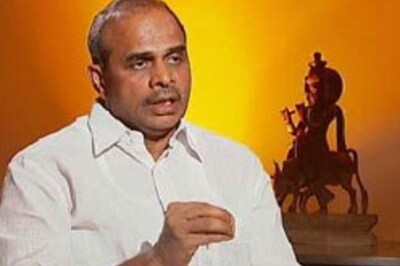
views
In a letter to Santa Claus, my seven year old didn’t wish for her favourite Unicorn or Peppa Pig. In fact, this year, the letter was too short but precise. “It’s boring. I want to go to school. I miss my friends. Open my school, Santa,” she wrote. It hit me hard. I thought she was doing fine except gaining weight, being a little fussy and spending too much screen time.
But then, I tried to explore what these children are losing. I found there are two different stories.
A – Loss of learning, impact on physical and mental development, poor social skills and slow cognitive development.
B – Overall regression of primary and secondary education in terms of re-entry in child labour market, early-marriage of girl-children, increase in drop-out rate among other repercussions.
In this column, let’s explore the reasons why all children should go back to school immediately.
Before we move ahead, here is an important fact: Schools across India were shut in March 2020 to curb the spread of the coronavirus. It was a correct move, as then, we knew nothing about the virus. Protecting vulnerable population, including children, was of utmost importance. However, now it’s almost 600 days where we have crossed two waves and know the virus better.
According to UNESCO, India ranks second in terms of the world’s longest school closures. Here, schools have been closed for 82 weeks or 1.5 years, between March 2020 and October 2021. Uganda ranks at number one with 83 weeks.
However, full closure on the national level has not been as long as partial closures and India ranks 76 out of 227 countries.
ALSO READ | Learning Losses Due to COVID-19 Could Cost $17 Trillion: UNICEF
Full closure means when schools were closed at the national level due to Covid-19. In India, for 25 weeks, schools were closed at national level (counted as full closure), whereas partial school closure stood at 57 weeks, which means school closures in some regions or grades.
The data by UNICEF shows, in India, school closures have impacted 24.7 crore children enrolled in elementary and secondary education and 2.8 crore children who were attending pre-school education.
ONLY MILD CASES REPORTED AMONG CHILDREN
Not even a single doctor, including neonatologists and paediatricians – all working in reputable private and public hospitals – told me that Covid-19 is lethal for children or any cause for concern.
So far, in all the three waves, “mild Covid-19” disease has been reported among children which recovers “within one week”. The link to a detailed story on how Covid impacts children and why it’s not lethal, here.
The government data shows that in the second wave, approximately 12% of the Covid-infected population was contributed by patients less than 20 years of age. However, there is not much data to show the present or overall trend of Covid illness among children.
In all hospitalisations, as per medical experts, Covid doesn’t appear to be causative but it is rather incidental. For instance: A child admitted in hospital due to liver disease was detected with Covid-19.
CAN’T WAIT TO VACCINATE CHILDREN
According to scientists and vaccine experts, there is no greater need for vaccinating children, especially those below 12 years of age.
NTAGI’s panel member and epidemiologist Dr Jayaprakash Muliyil told me in an interview that they have informed the central government that “children are doing fine and we should not be vaccinating children now”.
The decision of NTAGI – the apex panel taking decisions on vaccination in India – right now, was based on the fact that no mortality has been noticed among children due to Covid-19.
Also, vaccine expert Dr Gagandeep Kang had once told me that there are many unanswered questions India needs to deliberate on before it starts vaccinating children below 12 years.
In fact, we are not even sure which are the best vaccines that can be used to vaccinate young children.
ONLINE CLASSES ARE NOT A SOLUTION
Experts dealing with child psychology and teachers believe that social, emotional and cognitive capabilities cannot be developed in children through online education.
Sample this: Prolonged school closure has created a significant negative impact on younger children, a study by the Azim Premji University (APU) found.
The study found that on average, 92% children have lost at least one specific language ability and 82% have lost at least one specific mathematical ability from the previous year across classes 2-6.
The size of study was over 16,000 school children spanned across five states — Chhattisgarh, Karnataka, Madhya Pradesh, Rajasthan and Uttarakhand.
Disclaimer: The study was conducted in January 2021 – exactly one year ago. By now, the impact could be much higher than before.
As children take classes online, they also end up socialising more online.
However, a global study pointed out that “increased and unstructured time online may expose children to potentially harmful and violent content as well as greater risk of cyberbullying”.
“Spending more time on virtual platforms can leave children vulnerable to online sexual exploitation and grooming, as predators look to exploit the COVID19 pandemic,” a statement by UNICEF said.
PHYSICAL & MENTAL SYMPTOMS
Dry eyes, obesity, an acute vitamin D deficiency, poor sleep, temper issues and speech delay — these are some of the apparent impacts of Covid-19 on the wellbeing of children.
While several discussions have been ongoing over the mental impact of Covid-19 on the children, paediatricians have noticed a spike in the physical health issues due to the closure of schools which restricted mobility and led to sedentary lifestyle.
According to a paper by Indian Academy of Paediatrics, the most common psychosocial and behavioural problems among children and adolescents in the pandemic were inattention, clinginess and distraction.
They noted that the risk of developing these problems greatly increases if children have pre-existing mental health conditions.
MOVE BEYOND METROS
Estimates by UNICEF show that just a quarter of Indian households had internet access before the pandemic. Then what about online classes? How many people can afford multiple screens at home for their multiple schoolgoing children who have to attend online classes at the same time?
The survey called School Children’s Online and Offline Learning (SCHOOL) – conducted in August 2021 – found that of the nearly 1,400 school children in rural areas, only 8% were studying online regularly, 37% were not studying at all and about half were unable to read more than a few words.
Unfortunately, the dropouts at the secondary school level nationwide have increased and are as high as 17%, according to the Unified District Information System for Education.
This trend in rural India is harmful and regressive.
Abhijit Banerjee, an economist, had told Financial Times that many Indian children may never return to school, especially those that took jobs to help families. “Once you enter the labour market, it’s very hard to come back,” he said.
A very important concern raised by Banerjee is – Will we be able to recover the loss of learning smoothly? No, probably.
“For those returning to the classroom, the long-term consequences of the last year will depend on whether educators acknowledge the extent of lost capacities — and make realistic plans to help students re-gain them,” he told FT.
ALSO READ | Loans for Smartphones, Trekking Through Jungles: ‘Lost Generation’ Fears as Covid Locks Out India’s Poor Students
DIFFERENT STORY FOR GIRL CHILDREN
Girls have been severely affected by the closures.
According to the National Right to Education forum’s policy brief, 10 million girls could drop out of secondary school – hinting at a possible regression and failure of multiple education policies, programmes and NGOs who brought awareness in the community that pushed families to educate girl children.
The forum has sounded an alarm saying that the pandemic could also disproportionately impact girls increasing the risk of early marriage followed by early pregnancy and poverty.
FAMILIES AND TEACHERS ARE VACCINATED
Apart from protecting children from the virus, the idea behind closing schools was to stop the transmission of virus via children to their family members. Now, the majority of those family members are vaccinated with two shots against the severe Covid-19 disease.
The other concern was the spread of infection to and from teachers. Despite these concerns, the central government did not include teachers as “frontline workers” for priority access to Covid-19 vaccines. However, now even teachers are fully vaccinated.
So, what stops India from opening schools across age-groups and states? Take a look at district and block wise epidemiological data and start opening schools.
P.S: I constantly hummed while penning down this column.
“Savere, savere yaron se milne, Bun-than ke nikle hum…Ghar se door chalein hum, School chalein hum…”
Read all the Latest India News here




















Comments
0 comment